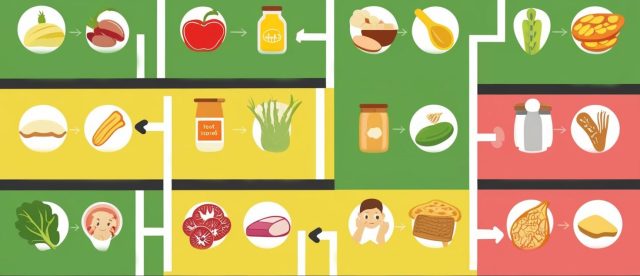This article is for informational purposes only and does not constitute medical advice. Always consult a qualified healthcare professional if you suspect a food allergy or experience unusual symptoms.
Food allergies are becoming more widely recognized, but some types remain extremely rare and unfamiliar to most people. In this list of the Top 10 Rare Food Allergies, we highlight unusual allergic reactions that may occur from everyday foods—sometimes with surprising effects.
Most people have heard of allergies to peanuts, shellfish, or dairy. However, there are lesser-known allergies that can lead to severe and even life-threatening reactions, such as developing hives after eating red meat or experiencing anaphylaxis from a banana. These rare cases reveal how unpredictable the immune system can be.
Interestingly, not all food allergies begin in childhood. Some can appear suddenly in adulthood, often catching people off guard. From fruit-induced oral reactions to allergies that only trigger during exercise after eating specific foods, the world of rare food allergies is both complex and fascinating.
This guide explores some of the strangest and least-known food allergies reported in medical literature and case studies. Whether you’re curious, health-conscious, or just love learning quirky facts about the human body, you’ll discover something intriguing in the sections that follow.
10. Maple Syrup Allergy
Imagine waking up on a cozy weekend morning, ready to drown your pancakes in golden maple syrup—only to find out you’re allergic to it. Yep, a maple syrup allergy is a real thing (unfair, right?), and while it’s super rare, it can cause quite a stir—literally and figuratively. Some folks break out in itchy hives or swelling around the mouth, get an upset tummy, or even feel short of breath after taking a bite of something sweetened with maple goodness1.
What’s even weirder? In one medical case, a person had no problem eating boiled maple syrup—but had a full-blown reaction to raw maple sap. Turns out, heating the syrup might destroy whatever sneaky compound was causing all the trouble2. Science is wild like that.
So, if you’re one of the rare few who can’t handle maple syrup, you’ve got a solid excuse to skip breakfast altogether—or just make your pancakes Canadian-style… minus the syrup. (We don’t make the rules!)
9. Garlic or Onion Allergy
Garlic or onion are rare food allergies, though they can cause symptoms such as skin rashes, itching, hives, or swelling, especially around the face and mouth. Digestive issues like stomach pain, nausea, and vomiting may also occur. In more severe cases, individuals may experience difficulty breathing, wheezing, or a runny nose. These reactions can be triggered by both raw and cooked garlic or onion, making it important to be cautious with various types of food preparation.
While rare, these food allergies can significantly impact daily life, especially for those who enjoy cooking with garlic or onion in their meals.
8. Corn Allergy
Corn allergies, though rare, can cause symptoms such as itching, hives, or swelling, especially around the face. Digestive reactions like cramps, nausea, or diarrhea may also occur. In more severe cases, individuals could experience breathing difficulties, dizziness, or even anaphylaxis—a serious allergic reaction that requires immediate medical attention.
This allergy can be triggered not only by direct consumption of corn but also by products containing corn-based ingredients, such as syrup, cornstarch, or cornmeal. Understanding the triggers of a corn allergy is important for managing symptoms and avoiding exposure to corn-containing foods and products.
7. Mango Allergy
A mango allergy is rare but can cause symptoms like skin rashes, itching, hives, or swelling, especially around the mouth and lips. Digestive issues such as stomach cramps, nausea, or vomiting may also occur. In more severe cases, difficulty breathing or anaphylaxis—a life-threatening allergic reaction—can happen, requiring immediate medical attention.
Interestingly, this allergy is often triggered by the skin or sap of the mango, meaning reactions can occur even from handling the fruit, not just eating it. Though relatively uncommon, understanding the symptoms and triggers of a mango allergy can help prevent accidental exposure and ensure proper treatment if needed.
6. Avocado Allergy
An avocado allergy can cause symptoms such as swelling, hives, itching, or digestive discomfort like nausea, vomiting, and abdominal pain. Severe reactions, including difficulty breathing or anaphylaxis, are possible. The allergy can be triggered by eating avocados or even by contact with the fruit’s skin or sap. It is sometimes linked to latex allergies due to shared proteins. However, this allergy is quite rare.
5. Sesame Seeds Allergy
A sesame seed allergy can cause symptoms such as itching, hives, or swelling, particularly around the face, mouth, and throat. Digestive issues, including stomach cramps, nausea, and vomiting, may also occur. In more severe cases, individuals may experience difficulty breathing, wheezing, or even anaphylaxis, a life-threatening allergic reaction. This allergy can be triggered by consuming sesame seeds or products containing sesame, such as tahini or sesame oil.
While sesame allergies are relatively rare, they are becoming more recognized, especially with an increasing number of food products containing sesame seeds. Awareness of this allergy is crucial for those affected to avoid triggers and manage symptoms effectively.
4. Rice Allergy
A rice allergy is quite rare, but it can cause symptoms like itching, hives, or swelling, especially around the face or mouth. Digestive issues such as nausea, vomiting, or stomach cramps may also occur. In severe cases, difficulty breathing, wheezing, or anaphylaxis can happen. This allergy can be triggered by eating rice or foods with rice-based ingredients, like rice flour or rice syrup. I can imagine how tough it would be to have this allergy, especially if you love Asian food! It would be hard to imagine missing out on so many delicious dishes.
3. Wine Allergy
A wine allergy, though rare, can cause symptoms like hives, itching, or swelling, particularly around the face or lips. Some individuals may experience digestive issues such as stomach pain, nausea, or vomiting. In more severe cases, difficulty breathing, wheezing, or anaphylaxis—a life-threatening allergic reaction—can occur.
Wine allergies can be triggered by specific ingredients such as sulfites, histamines, or proteins found in grapes or yeast. For those with sensitivities, reactions might also occur with other alcoholic beverages or foods containing similar compounds. Can you imagine not being able to enjoy a nice glass of wine with a delicious meal? It would definitely be tough to miss out on!
2. Red Meat Allergy
Red meat allergy, often associated with Alpha-Gal Syndrome, is a rare condition where the immune system reacts to a sugar molecule called alpha-gal found in mammalian meat. Symptoms include hives, swelling, abdominal pain, nausea, or vomiting, typically occurring a few hours after eating red meat. In more severe cases, difficulty breathing or anaphylaxis—a life-threatening allergic reaction—can happen, requiring immediate medical attention.
This allergy is sometimes triggered by tick bites, particularly from the lone star tick. While avoiding red meats like beef, pork, or lamb is necessary for those affected, it could make transitioning to a vegan lifestyle a bit easier—less temptation from all those delicious cuts of meat!
1. Water Allergy
Water allergy, or aquagenic urticaria, is an extremely rare condition, with only around 50 reported cases worldwide. People with this condition experience symptoms like hives, itching, or redness on the skin after contact with any type of water, including rain, sweat, or shower water. The exact cause of aquagenic urticaria is unclear, but it’s believed to be linked to the skin’s reaction to water molecules.
While this allergy typically doesn’t cause severe internal symptoms, it can significantly affect daily activities such as bathing or swimming. Treatment often involves antihistamines or other medications to help manage symptoms and improve quality of life.


